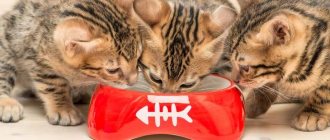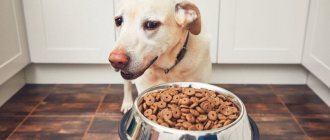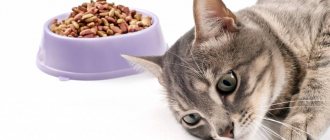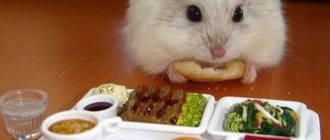The best food for a newborn puppy is its mother's milk. In addition to nutrients, it contains a huge amount of antibodies that babies need to protect themselves from illness. But time passes, they grow quickly, and mother’s milk becomes not enough. Usually the bitch feeds them for up to 1.5-2 months. But puppies need to introduce complementary foods much earlier, from about the third week of life.
Basic knowledge
The average fat content of a bitch's milk is 9-10%. The substitutes you choose should have exactly the same fat content or slightly less. Often, owners make a common mistake and start feeding their puppies too early. Often this is not necessary. If the puppies sleep most of the time and gain weight normally, then everything is fine and there is no need to get up at night with the intention of bottle-feeding them. Don't forget that a bitch produces as much milk as her puppies drink. That is, with supplementary feeding you will stimulate a decrease in its amount.
If something went wrong...
If puppies ignore the food, try to get them interested. Take one baby and gently bring his nose close to the bowl so that he can smell the meaty aroma and taste. You can take a small amount of food on your finger and anoint the baby’s nose or insert it into the animal’s mouth.
Severe coercion, of course, is unacceptable and can only strengthen the puppy’s negative attitude towards food. It's better to wait a day or two and then try again. Practice shows that when one of the puppies begins to be interested in complementary foods, the rest willingly follow his example.
In case of stool upset and vomiting, complementary feeding is also temporarily stopped or its amount is reduced. Reintroduction of dry puppy food should begin with small portions.
When to offer puppies a saucer
It depends on the specific situation. There are objective reasons why you need to supplement earlier. If the mother's milk supply is low or the litter is very large, goat's milk is the best choice. It is advisable to use raw, whole. You can add one yolk to a glass of milk. Before reaching four weeks of age, it is best to use quail eggs, and then add chicken eggs.
It makes sense to start feeding puppies at 14 days of age if weight gain has slowed down. If they continue to recover well, you can defer the introduction of additional feeds for another week. Or you can wait another week and start weaning on solid food from four weeks of age.
First feeding
Feeding puppies is necessary to ensure a painless transition from milk to solid food. The main characteristics of dog milk and the needs of young animals for nutritional components are shown in the table:
| Power Components | Dry matter content of feed, % | ||
| milk | food for puppies up to 8 weeks | feed for young animals over 2 months | |
| Squirrels | 35 | 35 | 30 |
| Fats | 43 | 20 | 17 |
Dog milk is thick and has a dry matter concentration that is twice as high as that of women's milk or cow's milk. The carbohydrate content is low and does not play a significant role in the baby’s energy nutrition. The purpose of complementary feeding is to provide a smooth transition from a diet rich in fat to a diet with moderate amounts of lipids.
Babies need to be constantly weighed and the result checked against the breed standard. If growth begins to decline after reaching two weeks of age, a decision is made to use additional nutrition.
If the growth rate of the cubs exceeds the standard limits, one should not rejoice. The genetic program for bone formation is programmed at a moderate speed. In large cubs, the bones do not support body weight, become bent, break, and cause death. With an increased rate of protein metabolism, the risk of urolithiasis increases.
The following complementary feeding schemes are distinguished:
- Transferring a pregnant female to ready-made food for puppies.
- Complementary feeding with factory feed mixtures.
- Complementary feeding with natural food.
Transferring a pregnant female to ready-made food for puppies
To ensure that the puppy is accustomed to solid food painlessly, the mother is fed correctly. When it is discovered that the bitch is pregnant, she is transferred to ready-made food of at least premium class for whelping, lactating bitches and puppies. Practice ad libitum feeding. That is, there should always be dry granulated food in the bowl. In such a situation, the mother is provided with adequate nutrition, the puppies will have enough milk and, possibly, no additional feeding will be required.
From the age of two or three weeks, the bitch begins to regurgitate food. Kids taste the soft granules. Puppies are curious; if someone eats something, others follow his example. The next step is to examine the mother's feeder. You can feed dry granules. If palatability is unsatisfactory, use canned food or soak the granules with three times the amount of water heated to 40° C. Increase the percentage of dry kibble daily. By six weeks of age, switch babies completely to puppy formula.
Start the transition from milk to solid foods with two feedings a day. Increase the number of meals gradually. By the time they are weaned, feed the puppies five times a day.
Complementary feeding with ready-made feed mixtures
If you practice natural nutrition or keep your bitches on an economy-class feed mixture, you will have to buy specialized puppy food for the babies - granular or wet.
The first complementary feeding is carried out with soaked feed mixture . Puppies are accustomed to liquid food - milk, so dilute canned minced meat in half with water. To make the dry granules the same consistency as milk, add three times the volume of liquid. In water heated to 40° C, the croquettes take a mushy form in 15 minutes. Crush them with a fork and make a puree from the food mixture.
If they don't eat, you'll have to poke it with your muzzle. The puppy will begin to lick his lips and he will like the food. Looking at his brother, others will follow his example. New food can have an unpleasant effect - after all, the baby’s enzyme system is not prepared for solid food. If diarrhea begins, complementary feeding is suspended.
Feed babies in a room inaccessible to the mother. The main thing is that there is no food left in the bowls. Otherwise, reduce the portion. Wash bowls thoroughly after eating so as not to leave food for pathogenic bacteria. With each feeding, the amount of moisture is reduced.
Complementary feeding with natural food
Adherents of natural nutrition will have to make efforts to balance the diet for the puppy. In addition to providing the feed mixture with complete proteins and fats, we must not forget about vitamin supplements. Ready-made premium and super-premium foods are rich in them, while natural products are poor. Another problem is the unsuitability of infant formula for long-term feeding to puppies. The ratio of nutritional components of dog, cow and human milk is not the same:
| Compound | Dog | Cow | Woman | |||
| % | In dry matter | % | In dry matter | % | In dry matter | |
| Dry matter | 22,8 | 12,4 | 11,9 | |||
| squirrels | 8,1 | 35,5 | 3,5 | 28,2 | 1 | 8,4 |
| fats | 9,8 | 43,0 | 3,8 | 30,6 | 3,9 | 32,8 |
| carbohydrates | 3,5 | 15,4 | 4,7 | 37,9 | 6,7 | 56,3 |
| energy, Kcal/g | 1,34 | 5,9 | 0,65 | 5,2 | 0,7 | 5,9 |
Bitches secrete a thick secretion that is twice as thick as the milk of cows and women. Puppies grow faster than calves, and especially children, which is why dog milk is superior to comparable products in protein content. Dogs get their energy from fats. The role of carbohydrates is small, so sweets are contraindicated for puppies. Canines love sweets, as evidenced by the Old Testament parable of the foxes in the vineyard, but sugar in high quantities is contraindicated for them.
However, dog breeders practice the first feeding with liquid semolina porridge. It is used as a flavoring agent to convince the puppy that there is other appetizing food besides milk. Prepare further baits based on rice porridge. The first dogs domesticated by humans tended sheep and ate milk and bread. Therefore, starchy foods in moderation are not contraindicated for dogs. And fermented milk products - cottage cheese or kefir - are even useful. They do not contain carbohydrates - sugars have turned into organic acids.
Complementary feeding begins with two feedings a day at 3-4 weeks of age. The frequency of meals is increased, bringing their number to five. In this case, an approximate diet consists of the following products:
- Rice porridge with canned food for puppies or meat.
- Cottage cheese, kefir or yogurt.
- Boiled rice cereal with minced meat.
- Milk porridge.
- Minced meat ball.
The video tells more about feeding one-month-old puppies with natural food:
Second month of life
The beginning of complementary feeding for puppies marks a new stage in the lives of babies. Now they are less and less dependent on their mother and spend more and more time exploring the world around them. Starting from week 5, additional foods can be introduced into the diet, one every three days. It is very important to prioritize the range of meats. Veal is a choice for first feeding, but not the only one. The only limitation is fatty pork, as well as pieces of lamb with tail fat. By the way, fatty chicken is also prohibited; you need to choose a young bird or remove excess fat.
At this age, milk ceases to play a primary role in the lives of babies. Now it is gradually being replaced by fermented milk products. It is best to prepare them for puppies yourself. In this case, you can be confident in the quality of the finished product. At the same time, raw calcined foods are better absorbed, so you should give them preference.
The first foods for puppies are an introduction to basic foods. Therefore, take into account the tender stomachs of babies and give them food in small portions. This will avoid stomach problems, bloating and diarrhea. Like a small child, a puppy’s gastrointestinal tract is still imperfect.
Temperature
Healthy newborn puppies sleep most of the time (up to 90%) during the first three weeks, and spend the rest of the time eating. Body temperature until the 20th day is about 36.5-38 °C . During this period, the puppy must be provided with a constant, comfortable temperature regime, since he cannot independently maintain body temperature , even in a blanket.
If the puppy's body temperature is below normal, this is hypothermia. In this case, you must immediately warm it up by placing it on your body (under your jacket) . This is a long process: if the body temperature is 35 degrees, then warming up will take from 2 to 3 hours!
Under no circumstances should you warm up hypothermic puppies quickly (with a heating pad and especially on a radiator)! By doing this, you will only deprive the baby of his last strength and provoke unnecessary vasodilation.
A chilled puppy should not be fed either mother's milk or artificial food, since the stomach and small intestines will not be able to cope with the load in this case. During the warming process, he is given a 10% glucose solution with water (3.5 ml per 100 g of body weight) once an hour. Instead of glucose, you can use a solution of honey, or, in extreme cases, sweetened water: 3/4 teaspoon per 100 ml of water.
To accommodate newborns, it is necessary to organize a “nest”. It can be a box, the volume of which is sufficient to comfortably accommodate the puppies. Disposable diapers or cotton cloth can provide additional warmth and dryness. They need to be changed when they become dirty. The optimal temperature in the nest is +37. You can use an electric heating pad with a thermostat, warm water bottles, or a medical rubber heating pad.
Important : after 7 days from birth, puppies need to cut their claws and repeat the procedure every week. This process must be done as carefully as possible so as not to touch the nerve endings.
You can and should only trim the curved tip of the claw, no more than 1 mm!
Don’t be alarmed that the puppies only eat and sleep: this is necessary, because they are growing! Babies will open their eyes between 11-15 days of life, and will begin to hear on the 18th day.
Vitamins and minerals
When to start feeding puppies, each owner decides independently, focusing on their charges. If the mother feeds them well, then calmly enjoy a carefree life until they are 3-4 weeks old. But if the bitch does not have milk or, even worse, she gets sick or dies, then you will have to take care of feeding the babies.
From 6 weeks, puppies begin to be offered raw fish. It is a source of phosphorus and calcium. From this time you can begin to introduce vegetables and fruits into your diet. These are apples and carrots, lettuce and cucumbers, zucchini and pumpkins. Fish and meat bones can be fed to the puppy in ground form, mixed with meat. Do not forget that their share should not be more than 15%. You can and should give your kids large beef bones. This is a toy and a treat, and also a necessary thing for scratching growing teeth. But bones should only be given to well-fed puppies at night. At this age they are fed 6 times a day, and by 8 weeks the number of feedings is reduced to 3-4 times a day.
How to soak food
One of the basic rules for soaking dry food is not to stock it up. Dry food diluted with water quickly deteriorates and loses its beneficial properties, which can cause disruption of the digestive system. You need to prepare food in the amount that the puppy will eat at one time.
The algorithm for soaking food is incredibly simple and consists of only two points:
- Pour the required volume of granules with purified or boiled water at a temperature of about 40 degrees.
- Leave for 20-40 minutes to soften, then offer to the puppy.
The degree of soaking directly depends on the time spent in water. The longer you wait, the more the food will resemble porridge.
Note! If the puppy has not eaten all the soaked food, the leftovers should be placed in the refrigerator and stored there for no more than 12 hours.
Many novice dog breeders do not realize the consequences of not feeding a puppy correctly. In the first months of life, the fundamental foundation of a pet's health is laid, and an incorrect diet will do everything possible to undermine the puppy's condition. If you have difficulty creating a menu on your own, it is better to seek help from a veterinarian.
From 8 weeks
By this time, the digestive system has time not only to form, but also to get stronger. Puppies can start giving offal. But you also need to choose them carefully. For example, the puppy will swallow chicken necks, but will gnaw on the backs. Tripe can also be given in the proportions recommended for adult animals. The frequency of feedings is now gradually decreasing, but the portion is increasing.
A baby at this age eats as much as an adult dog of the same breed, if you take the daily amount of food. Males always eat more than females. For normal digestion, you must add chopped fresh herbs. By this age, the number of feedings per day is reduced to three, but the diet should still include fermented milk products.
Using vitamins in puppy food
Experienced breeders know how important vitamins are for a growing body, so they do not forget to add them to the food at the age of 2 months. The easiest way to purchase it is at the Trivit pharmacy. This is a mixture of vitamins A, E and D3 - the most important for dogs.
In addition, if you have to work with a large dog, you can add to the diet not only fermented milk products, but also preparations containing calcium - chalk or calcium gluconate. If this is not done, the grown pet may have problems with the musculoskeletal system.
Feeding Yorkshire puppies
Depending on the breed, the rules for introducing complementary foods may vary. This is especially true for miniature animals that are bred artificially. Tiny Yorkies quite often experience digestive problems. The stomach is often simply not able to digest the volume of food that the body needs due to its size. Therefore, special feeds are used for them, which, in a small volume, provide a good supply of nutrients.
Therefore, complementary feeding of a Yorkie puppy is most often carried out using soaked dry food “Starter Pappy”. Mash it with a fork until it becomes a paste. And when the kids grow up a little, they simply eat it soaked and wash it down with water. From two months you can switch to Mini Junior. Most breeders agree that this is the best feeding for Yorkies.
How to teach a puppy to eat from a bowl
The procedure is quite simple. Often, puppies, attracted by the tasty smell, eat from the bowl themselves. If this does not happen, you can lightly poke your pet’s nose into the treat - he will be forced to lick his nose and lips, feel the taste of the food and start eating.
On a note! When feeding natural food, you need to make sure that the cup (especially if a metal one is used) is not hot - if it gets burned, the puppy will retain a dislike for the bowl for the rest of its life.
At this stage, it is important not to scare your pet. Otherwise, he will simply be afraid to eat from a cup, and this will cause a lot of problems for the owner.
You can't yawn in a big family
Understanding all the intricacies of feeding a puppy is not that difficult. Therefore, nothing will prevent you from providing your pet with tasty and healthy food from the first weeks of life.
Large breed dogs
The most popular can be considered the German Shepherd. Complementary feeding of shepherd puppies begins from 18-20 days of life. These puppies are quite large and require a lot of calcium and nutrients to grow and develop. From this time on, calcined cottage cheese can be introduced. It performed very well in the combination “cottage cheese - milk - raw egg” or “cottage cheese - egg - carrot juice”. From day 22 you can add lean beef. To do this, it is scraped or ground in a blender. A good option would be a mixture of milk, cottage cheese and minced meat.
From about 26 days of life, milk porridge can be introduced into the diet. Cereals must be ground in a coffee grinder. Start with one cereal, and when your baby’s stomach gets used to it, you can add the next one.
How to wean puppies off their mother's milk
The bitch actively feeds the babies up to six to eight weeks of age. Then the amount of milk begins to decrease, so the puppies simply have no choice but to switch to the food provided by the owner. Well, he should know not only when to start feeding the puppies, but also how to do it correctly.
What and how to give puppies after one month of age
When the puppy turns one month old, it’s time to introduce him to solid food. Moreover, this applies to dogs, regardless of age - even a tiny pug, a miniature Spitz, or a fairly large Labrador or German shepherd. It is necessary to feed the puppies so that they receive enough nutrients, because there is no longer enough mother's milk for everyone.
To begin with, it is best to use lean meat (chicken, rabbit, veal), finely chopped or minced. You can also use cottage cheese (but not the cheap cottage cheese product). Some breeders add eggs to the cottage cheese from the first feedings - one quail per 200 grams or one chicken per 700 grams.
Healthy! It is advisable to wash eggs before eating to reduce the risk of poisoning or parasite infection.
Company always tastes better
How much food does a puppy need?
For medium and large breed puppies, there is a clear formula: they need 5 to 8% of their body weight. Moreover, this portion is adjusted once a week. But the main guideline remains the condition of the puppy. He shouldn't get fat or look thin. You can focus on the ribs. They should not bulge, but upon palpation they can be easily felt. If the puppy is cheerful, runs around a lot and is interested in the world around him, he will definitely have a good appetite. At the same time, it is necessary to provide him with high-quality food, complete sources of all necessary nutrients.
Rules for switching to dry food
A complete transition to dry food with abandonment of mother's milk is practiced at 2-2.5 months. Until this moment, the baby is introduced to the new product through feeding.
When to start feeding puppies dry food
The first acquaintance is organized from 3 weeks of life. The pet is given a pre-soaked starter and wet canned food. Feeding too early is useless, since the newborn’s stomach is adapted to only one type of food - mother’s milk. He simply cannot digest everything else.
What should you not feed your puppy?
A puppy of any age, like an adult dog, should not be fed cold or hot food. In addition to this axiom, there is a list of foods prohibited for puppies:
- flour and bakery products;
- sweets;
- foods that cause fermentation (legumes, cabbage, plums, grapes);
- spices and herbs;
- roast;
- excess salt;
- sauces (ketchup, tomato, mayonnaise).
Important! Bones are not allowed in a puppy's diet. And not only chicken (tubular) ones. Any bones, especially when boiled, only cause harm. The exception is bone broths and sugar bones for puppies as entertainment.
Treats
Of course, you will pamper your beloved little dog with various treats and treats.
Do not forget that all treats offered to the puppy must be taken into account as part of the daily portion of food. The volume of treats should not exceed 5% of the daily protein intake.
It is best to offer natural, homemade treats as treats. They are easy to prepare and do not contain any preservatives or harmful substances. See the “Nutrition” section of our blog. There you will find many different recipes for homemade treats for dogs.
Review of 10 foods that are suitable for a one-month-old puppy
Puppies can be fed the following foods:
- Royal Canin Starter.
- Eukanuba for puppies 1-12 months.
- Trainer for puppies and teenagers.
- Bosch Junior.
- Farmina N&D for puppies.
- Go Natural holistic.
- Orijen.
- Probalance Starter.
- Grandorf.
- Genesis Pugh Canada.
Royal Canin Starter
The cost of 1 kg is 532 rubles.
ROYAL CANIN STARTER food
Premium food meets the needs of pregnant and lactating bitches, suckling puppies and weanlings up to 8 weeks. Croquettes are easy to soak.
The following components were used in the feed mixture:
- Animal feed - poultry meat, protein hydrolysates, egg powder, fats.
- Plant ingredients: rice, corn, protein isolate, soybean oil, beet chips.
- Biologically active components - prebiotics FOS, MOS, marigold luteins, microelements, vitamins.
Start feeding at twenty days of age. The feed mixture contains proteins and fats in concentrations of 30 and 22%.
Read more about Royal Canin food.
Eukanuba for puppies 1-12 months
Cost 0.5 kg - 350 rub.
Food EUKANUBA Puppy 1-12 months
Universal premium food suitable for whelping and lactating bitches and young animals from one month to one year of age.
The manufacturer used the following components:
- Animal feed - dehydrated poultry meat, whole eggs, protein hydrolysates, egg powder, fats.
- Plant components: barley, wheat, beet pulp.
- Biologically active substances - prebiotics FOS, brewer's yeast, trace elements, vitamins.
The food is started to be fed to pregnant bitches. Babies learn to eat by observing their mother's behavior. The feed mixture contains proteins and fats in amounts of 32 and 21%.
TRAINER for puppies and teenagers
The cost of a 3 kg package is 1,723 rubles.
Food TRAINER Puppy & Junior mini
The food is universal. As soon as you notice that the girl is pregnant, feel free to replace the usual food with Trainer. Cubs do not need to be taught to eat. They watch their mother and get used to the pelleted food. The food does not contain grain components and is holistic.
The manufacturer used the following ingredients:
- Animal origin - turkey, chicken, fish meal, pork, fats.
- Plant products: pea fiber, beet pulp, corn oil, flax seeds, apples, blueberries.
- Biologically effective ingredients - chicory extract, brewer's yeast, shellfish extract, FOS prebiotics, brewer's yeast, methionine, trace elements, vitamins.
The feed mixture contains proteins and fats in amounts of 30 and 16%.
Bosch Junior
The cost of packaging 1 kg is 819 rubles.
Bosch Medium Junior food
Super premium food is intended for weanlings and adolescents, but is suitable for pregnant and lactating bitches. Puppies are trained to consume food from their mothers. The food has a semi-moist consistency, so puppies prefer it to dry kibble.
The manufacturer included the following components in the feed mixture:
- Animal feed - poultry meat, fats, fish meal, protein hydrolysates.
- Plant ingredients: barley, rice, corn, beet pulp, flaxseed.
- Biologically active substances - shellfish extract containing chondroprotectors for the formation of cartilage tissue, microelements, vitamins.
The food contains fats and proteins in amounts of 13 and 26%.
Farmina N&D for puppies
Cost 2.5 kg - 1320 rub.
Farmina N&D Medium food
Super premium low-grain food is prescribed for feeding puppies, adolescents, pregnant and lactating bitches. The following components were included in the feed mixture:
- Animal feed - chicken, herring, protein hydrolysates, whole eggs, fats.
- Plant components: oats, spelt (spelt), pea fiber, carrots, alfalfa, apples, pomegranate, plantain, turmeric, calendula, oranges, beets, blueberries.
- Active substances: prebiotics FOS, MOS, chondroprotectors, microelements, vitamins.
The concentration of proteins and lipids is 35 and 20%.
Go Natural holistic
Cost 2.5 kg - 1320 rub.
Go Natural holistic food
Low grain holistic food can be used as the only nutrition throughout life. The feed mixture was made up of the following components:
- Components of animal origin - lamb, fats.
- Plant ingredients: oatmeal, brown rice, rice bran, alfalfa, cranberries, carrots, apples, seaweed, flax seeds, coconut and canola oils.
- Active ingredients - chicory rhizome, yeast extract, probiotics - lactobacilli, taurine, methionine, lysine, rosemary, yucca, trace elements, vitamins.
The feed mixture contains 24% protein and 14% fat. Cost 2.72 kg - 1810 rub.
Orijen
Cost 2.27 kg - 2024 rub.
This is a new class of food - nutrition that is biologically appropriate. The recipe is made taking into account the food preferences of the wild ancestors of dogs. The manufacturer has prepared dry food for lactating, pregnant females, weaned puppies and adolescents with the following composition:
The food contains proteins, fats in the amount of 38; 20%.
Probalance Starter
Cost 10 kg - 1655 rub.
Pro Balance Starter food
Premium food was made for lactating, pregnant females and puppies up to three months of age. Nutrition is used by analogy with Royal Canin Starter food.
The following components were included in the feed mixture:
- Animal feed - poultry, fish meal, milk powder, egg powder, fats.
- Plant components: rice, brown barley, flax seeds, beet pulp, sunflower oil.
- Active substances - a complex of medicinal herbs, prebiotics, lysine, carnitine, Yucca extract, vitamins, microelements, Mycocarb.
The feed mixture contains 30% protein and 18% fat.
Grandorf
Cost 1.0 kg - 650 rub.
Food GRANDORF Puppy all breeds from 3 weeks
Holistic food for puppies, pregnant and lactating females was made up of the following components:
- Animal components - lamb, turkey, Antarctic krill fats.
- Plant ingredients: brown rice, carob, cranberries, apples.
- Active ingredients - brewer's yeast, a complex of natural antioxidants, taurine, chondroprotectors, Yucca extract.
The feed mixture contains 29% proteins, 18% lipids. Read the review of Granddorf food.
Genesis Pugh Canada
Cost 0.91 kg (2.5 pounds) - 950 rub.
Canadian dog food is considered the best in the world. The grain-free holistic formula for weaned, whelping and lactating bitches has the following composition:
- Animal feed - chicken, goat meat, lamb, protein hydrolysates, milk powder, colostrum, mussel extract.
- Plant ingredients: bananas, lentils, chickpeas, cranberries, blueberries.
- Active substances are a mixture of medicinal plants.
The food contains 35% protein and 20% fat.
Serving Size
The amount of food a dog consumes is usually calculated based on the animal's body weight. The norms are quite arbitrary. Puppies of the same age and breed can consume different amounts of food. It all depends on metabolism, level of physical activity, time of year, and so on. The criterion is the physical condition of your furry friend. If the puppy gets fat, we cut the portion, and if he loses weight, we add accordingly.
You can find out in more detail how to determine the amount of food offered to a dog by reading the material: How much food should be given to a dog on a raw food diet.
These are roughly the basic principles of feeding raw natural food to puppies. As you already understand, there is nothing complicated about feeding your dog raw foods.
Good luck and take care of your pets!
Healthy Colostrum
In order to best meet the puppies' needs for quality nutrition, the composition of the bitch's milk changes at each certain period of the puppies' life. So, for example, in the first few days the bitch produces colostrum,
which contains a huge amount of nutrients, vitamins and minerals, as well as a full set of immunoglobulins (antibodies), which, when entering the body of puppies, form passive immunity to various diseases. It is very difficult to overestimate the importance of colostrum - which is why it is extremely important that puppies are under the bitch for the first 3-5 days and receive their dose of benefit and protection.











